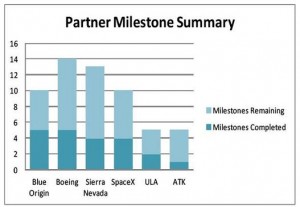Source NASA: Over the last two months, NASA’s industrypartners demonstrated substantial progresstoward achieving crewed spaceflight in the middle of the decade by completing six more Space Act Agreement milestones. In just six short months since the Commercial CrewDevelopment Round 2 partners were selected, they have completed 21 of the 57 planned milestones.
The Sierra Nevada Corporation completed their functional Vehicle Avionics Integration Laboratory (VAIL), which will be used to test Dream Chaser computers and electronics insimulated space mission scenarios. Initially, the VAIL will be utilized for developmental testing, and then later as a key tool forDream Chaser certification. Blue Origin LLC successfully completed two technical reviews. Their space vehicle Mission Concept Review (MCR) identified proposed mission objectives as well as the design concepts to meet them. Also, in preparation for their Reusable Booster System (RBS) engine component testing next year, Blue Origin presented their test plan and test article interface data to NASA experts.
Space Exploration Technologies (SpaceX) successfully completed a Preliminary Design Review (PDR) of their Launch Abort System propulsion components. This review demonstrated that SpaceX is ready to proceed with detailed design, fabrication, assembly, integration, and testing of the component test articles. United Launch Alliance completed a Design Equivalency Review (DER), which presented their Atlas V requirements and certification process development to NASA technical experts for feedback. Boeing successfully completed a major testing milestone for the air bags used to land their capsule.
In the video, below, testing of Boeing’s CST-100 airbag system. A summary schedule showing all completed and planned CCDev2 milestones can be found at http://www.nasa.gov/exploration/commercial


















































































































![A trajectory analysis that used a computational fluid dynamics approach to determine the likely position and velocity histories of the foam (Credits: NASA Ref [1] p61).](http://www.spacesafetymagazine.com/wp-content/uploads/2014/05/fluid-dynamics-trajectory-analysis-50x50.jpg)



Leave a Reply